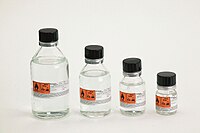
Photo from wikipedia
Metal carbonyl complexes, which have been known as effective catalysts since early days, find use in many fields both directly and indirectly. Although the use of metal carbonyl complexes as… Click to show full abstract
Metal carbonyl complexes, which have been known as effective catalysts since early days, find use in many fields both directly and indirectly. Although the use of metal carbonyl complexes as bio-probe and protein labeling agent due to their unique spectroscopic properties is known, metal carbonyls have recently been used as storage and transport carriers of carbon monoxide. These developments have motivated the synthesis of new metal carbonyl complexes. Despite the difficulties in obtaining prediction for the molecular properties of organometallic compounds, DFT-based calculation programs have been able to gain insight into the structural/electronic properties of inorganic and organic molecules.In this study, structural, electronic, and reactivity properties of characterized molybdenum and tungsten carbonyl complexes with benzimidazole and imidazoline derivative ligands were investigated using DFT-based calculation program ORCA.
Journal Title: Structural Chemistry
Year Published: 2018
Link to full text (if available)
Share on Social Media: Sign Up to like & get
recommendations!